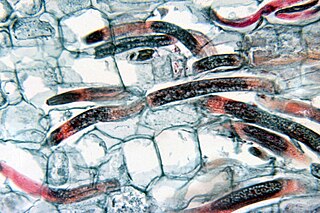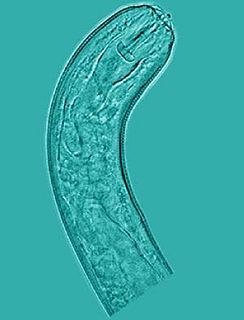A nematicide is a type of chemical pesticide used to kill plant-parasitic nematodes. Nematicides have tended to be broad-spectrum toxicants possessing high volatility or other properties promoting migration through the soil. Aldicarb (Temik), a carbamate insecticide marketed by Bayer CropScience, is an example of a commonly used commercial nematicide. It is important in potato production, where it has been used for control of soil-borne nematodes. Aldicarb is a cholinesterase inhibitor, which prevents the breakdown of acetylcholine in the synapse. In case of severe poisoning, the victim dies of respiratory failure. It is no longer authorised for use in the EU and, in August 2010, Bayer CropScience announced that it planned to discontinue aldicarb by 2014. Human health safety and environmental concerns have resulted in the widespread deregistration of several other agronomically important nematicides. Prior to 1985, the persistent halocarbon DBCP was a widely used nematicide and soil fumigant. However, it was banned from use after being linked to sterility among male workers; the Dow Chemical company was subsequently found liable for more than $600 million in damages.

Radopholus similis is a species of nematode known commonly as the burrowing nematode. It is a parasite of plants, and it is a pest of many agricultural crops. It is an especially important pest of bananas and citrus, and it can be found on coconut, avocado, coffee, sugarcane, other grasses, and ornamentals. It is a migratory endoparasite of roots, causing lesions that form cankers. Infected plants experience malnutrition.

Meloidogyne incognita is a species of nematodes (roundworms) in the family Heteroderidae. It is commonly called the "southern root-knot nematode" or the "cotton root-knot nematode". This parasitic roundworm has worldwide distribution and numerous hosts. It is an important plant parasite classified in parasitology as a root-knot nematode, as it prefers to attack the root of its host plant.

Xiphinema is a genus of ectoparasitic root nematodes commonly known as dagger nematodes. The genus is of economic importance on grape, strawberry, hops and a few other crops. Major species include X.americanum, X.diversicaudatum, X.index, X.italiae and X.pachtaicum. They can be easily recognized by their long bodies and stylets which are long enough to reach the vascular tissue of plants. Different members of the genus have been shown to induce moderate to large amounts of root damage through root penetration, which in some species results in the formation of galls. They are of agricultural concern because they are vectors of nepoviruses, transferring them during feeding. Efforts to study these nematodes in more detail have proved problematic in some species due to difficulties in maintaining populations in a greenhouse environment.
Belonolaimus longicaudatus is a common parasite of grasses and other plant crops and products. It is the most destructive nematode pest of turf grass, and it also attacks a wide range of fruit, vegetable, and fiber crops such as citrus, cotton, ornamentals, and forage. The sting nematode is a migratory ectoparasite of roots. It is well established in many golf courses and presents a problem in turf management. The sting nematode is only present in very sandy soils. It cannot reproduce in heavier or clay soils.
Rotylenchulus reniformis, the reniform nematode, is a species of parasitic nematode of plants with a worldwide distribution in the tropical and subtropical regions.
Anguina tritici is a plant pathogenic nematode.
Helicotylenchus multicinctus is a plant pathogenic nematode that affects primarily bananas and plantains. Nematodes of the genus Helicotylenchus are spiral nematodes and feed on a large variety of plant species.
Hirschmanniella oryzae, i.e. rice root nematode (RRN), is among the major pests of rice and is the most common plant-parasitic nematode found on irrigated rice. Recent modifications in cultivation practices have led to a substantial increase in rice production, which has been accompanied by heightened levels of RRN. The proportional increases in RRN with rice production can be explained by the nematode's impeccable adaptation towards constantly flooded conditions in which irrigated rice is often being grown.
Xiphinema diversicaudatum is an amphimitic ectoparasitic nematode species. This species has a characteristically long stylet capable of penetrating into a host’s vascular tissue. They have a wide host range with some of the extensively studied ones being strawberry, hops and raspberry, due to their economic importance. The direct root damage caused through penetration near the root tip and formation of galls is a secondary concern when compared with the damage caused by vectoring the arabis mosaic virus. The virus attaches to the interior cuticle lining and can be transferred from infected to uninfected root tissue as the nematode feeds and sheds. Management of this particular nematode relies on nematicides such as 1,3-Dichloropropene (Telone) at 40 gpa.or methyl bromide at 1000 lb/ac to control to 28 in deep.
Tylenchulus semipenetrans is a species of plant pathogenic nematodes and the causal agent of slow decline of citrus. T. semipenetrans is found in most citrus production areas and diverse soil textures worldwide. Their feeding strategy is semi-endoparasitic and has a very narrow host range among commonly grown crops. These nematodes are considered as major plant-parasitic nematode because they can cause 10-30% losses reported on citrus trees. They also parasitize other hosts such as olive, grape, persimmon and lilac. The citrus nematode was first discovered in California in 1913 by J.R. Hodges and was later described and named by Nathan Cobb that year.
Mesocriconema xenoplax is a species of plant parasitic nematodes. Nematodes of this particular species are collectively called ring nematodes.
There are many plant-parasitic species in the root-knot nematode genus (Meloidogyne) that attack coffee such as M. incognita, M. arenaria, M. exigua, M. javanica and M. coffeicola. Study has already shown interspecific variability coffee, in which show how this species can be adapting to new hosts and environments.
Belonolaimus is a genus of nematodes. They are known commonly as sting nematodes. They are ectoparasites that feed on plant roots, sometimes becoming agricultural pests. They are found in the United States, Mexico, and Puerto Rico.

Pratylenchus is a genus of nematodes known commonly as lesion nematodes. They are parasitic on plants and are responsible for root lesion disease on many taxa of host plants in temperate regions around the world. Lesion nematodes are migratory endoparasites that feed and reproduce in the root and move around, unlike the cyst or root-knot nematodes, which may stay in one place. They usually only feed on the cortex of the root. Species are distinguished primarily by the morphology of the stylets.

The nematodes or roundworms constitute the phylum Nematoda. They are a diverse animal phylum inhabiting a broad range of environments. Taxonomically, they are classified along with insects and other moulting animals in the clade Ecdysozoa, and unlike flatworms, have tubular digestive systems with openings at both ends.
Helicotylenchus is a genus of nematodes in the family Hoplolaimidae. They are known generally as spiral nematodes. They are found worldwide because they can live and survive in a wide range of habitats. They are among the most common parasitic nematodes of plants; found in corn, bananas, grass, soybeans.
Scutellonema bradys, also known as yam nematode, is a migratory endoparasitic nematode causing major damage to yam crop in many African tropical regions, as well in parts of South and Central America and Asia. They can cause reduction of 20-30% in tuber weight at harvest.
Johannes Hallmann is a German agricultural scientist of phytomedicine. He is a scientific adviser at the Julius Kühn-Institut, the Federal Research Institute for Cultivated Plants, the Institute for Epidemiology and Pathogen Diagnostics in Münster, the University Professor for Nematology and the President of the German Phytomedicine Society.






